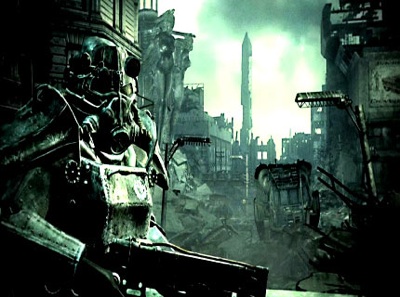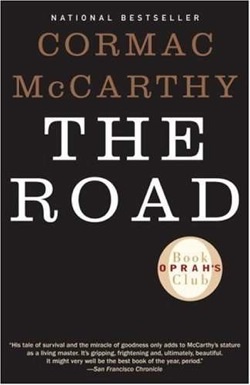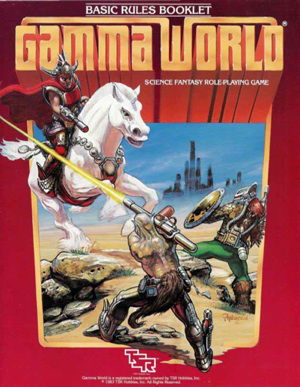We’ve seen a marked rise in appearances of post-apocalyptic worlds lately, from films (I Am Legend) to literature (Cormac McCarthy’s The Road) to video games (Fallout 3). Even movies like Pixar’s wonderful Wall-E draw on post-apocalyptic images and themes.
Then there’s the zombie apocalypse, a well furrowed field of apocalyptic fiction, now firmly entrenched in pop culture, continuing to take shape in new films, games and books (like S.G. Browne’s Breathers).
My love affair with the post-apocalyptic came when I, a young Dungeons and Dragons enthusiast, discovered the game Gamma World, a post-apocalyptic roleplaying game from TSR. I found that post-apocalyptic worlds were a fascinating backdrop in which to tell stories. Aside from the overall theme—people trying to find hope and a future in wasted landscapes—there were countless other details that I found exciting. The mix of cultures and technology levels, for example. High-tech remnants of previous civilizations existing alongside primitive weapons and technology. Mutants wandering ruined landscapes with amazing and unexpected abilities. Worlds where the mundane, a can of beans or a street sign, suddenly became objects of value and power.
What spoke to me, what I found romantic about the genre, was clothing the familiar with the unfamiliar. Superimposing a fantastical, but translucent, setting upon our own, where if you look hard enough you can see the original background. The idea of someone scraping dust off a street sign that says “Wall Street” or climbing the remains of the Washington Monument.
It’s the part of Planet of the Apes when you see the buried Statue of Liberty, that “oh my god” moment when something that seems so other is exposed as something so familiar.
Gamma World was my introduction to the post-apocalyptic. Later, I came across the Battle Circle books by Piers Anthony which deals with a world after a nuclear blast and the fragmented society that comes out of it. Some of the humans left safeguard technology and learning while other nomadic tribes participate in ritualized fighting matches inside a circle.
From there I moved on to The Road Warrior and its less exciting sequel. To the future landscapes of H.G. Wells’ The Time Machine. To There Will Come Soft Rains. To Planet of the Apes, Logan’s Run, and Thundarr the Barbarian.
 Then came the late 90s, and the release of Fallout, the computer game. Seeing it presented in game form, allowing me to become part of that world, gave me the same excitement I had when I’d first discovered the genre. Fallout was an incredible game in its own right, but the world that Interplay created was really the star. A future after a nuclear holocaust fully infused with the flavor of the 50s and 60s. The game allowed the player to explore and interact with a range of settings and characters, fully immersing one in the post-apocalyptic storyline. It spawned several sequels and spin-offs, most recently Fallout 3, which drapes the same world on a much more technologically advanced frame.
Then came the late 90s, and the release of Fallout, the computer game. Seeing it presented in game form, allowing me to become part of that world, gave me the same excitement I had when I’d first discovered the genre. Fallout was an incredible game in its own right, but the world that Interplay created was really the star. A future after a nuclear holocaust fully infused with the flavor of the 50s and 60s. The game allowed the player to explore and interact with a range of settings and characters, fully immersing one in the post-apocalyptic storyline. It spawned several sequels and spin-offs, most recently Fallout 3, which drapes the same world on a much more technologically advanced frame.
The causes of these little booms in post-apocalyptic worlds are difficult to determine. Is it simply a cyclical pattern, rising and falling in each generation, or is there a relation with current events? The last surge in post-apocalyptic fiction coincided with the Cold War, when it wasn’t too difficult to imagine a world recovering from a nuclear war. Today we have the specters of climate change, lack of renewable energy sources, and even meteor impact to worry about. But is the current manifestation of these ideas just nostalgia, a longing for simpler times when nuclear war was our main worry? Or is this a reflection of our current fears?
 Most of these recent films and books and games were developed during a relatively prosperous time for the US and for much of the rest of the world. Now that the world is in a slightly more insecure place, will the allure of the postapocalyptic still remain? Will people want something more comforting, more reassuring to cling to?
Most of these recent films and books and games were developed during a relatively prosperous time for the US and for much of the rest of the world. Now that the world is in a slightly more insecure place, will the allure of the postapocalyptic still remain? Will people want something more comforting, more reassuring to cling to?
I hope not. To me, post-apocalyptic stories are, at their heart, stories of hope. Of people finding a future and a glimmer of light in the dark days of a future landscape. They are stories of people overcoming the hardest of challenges. Surely they can serve as examples that we, on the other side, can conquer the same forces that might lead us there.
Whichever way the pendulum swings, I am doing my best to appreciate the examples that we’ve currently been given. In future posts, I will look at different explorations of post-apocalyptic worlds from books to games to film and television. Even comics. I hope you’ll join me.











While post-apocalyptic worlds can be written as stories of hope, I see them as coming from a more cynical mind-set. IE no matter how ‘good’ things are, things will be going bad.
While I haven’t seen the new Battlestar series, from what I’ve heard it shows the same cynical mind-set. The ‘heroes’ can not be heroic and must lose.
For that matter, I got away from the Comics because they show this cynical mind-set.
It doesn’t matter how well the country’s economy is going, it matters how the writers/movie makers think things are ‘really’ going.
Oh, not being involved in the Gaming World, I can’t comment on the Games.
Drak Bibliophile
Wow, I went on a serious nostalgia trip looking at the cover of Gamma World. I loved that game!!
As for what causes spikes in postapocalyptic fiction, I’m not sure either. But I think your point that they are stories of hope is pretty insightful. Even I am Legend (the book) has if not a happy ending at least one with a sense of accomplishment. I think the idea is that you create a world of devastation and horror, reducing people to savages, and then in the middle of it all, show a protagonist with a desire to move forward despite it. Not just survive, but move, create, make sense of it all. Of course, some of these movies end on a really cynical note, but still, I think your point about hope is key.
So, if that is the case, maybe we create (or seek) postapocalyptic fiction when we feel out of control.
“The last surge in post-apocalyptic fiction coincided with the Cold War, when it wasn’t too difficult to imagine a world recovering from a nuclear war.”
Given the duration of the Cold War I’d have trouble distinguishing the surge in post-apocalyptic fiction from Star Trek TOS.
Wow, Raj — your path to postapocalyptic love was nearly the same as mine (Gamma World!!), except diverging at the videogame point. Your love was Fallout 3; mine was Digital Devil Saga, which starts out in what might be the most beautiful wasteland I’ve ever seen and later travels to one even more surreallishly lovely. Thanks for noting that the romance is part of it — the beauty lost, the potential for growth which will nevertheless reclaim what was destroyed, the lone hero (or inadequately-small team) wandering endlessly on an existential quest. I felt a moment of that in the Battlestar Galactica season 3 finale, when —
(D’oh, spoiler space)
— we saw that shattered landscape and really *felt* the emotional impact because that was supposed to be *us*.
Dunno about the apocalypse as control mechanism, though. That may be true of Golden-Age and Baby-Boomer postapocalypses, which were invariably written by libertarian-leaning men who viewed the end of the world as a great chance to start over fresh. But are we really seeing that in modern postapocalyptic fiction? These days it seems like most apocalypses end with “rocks fall, everybody dies”. BSG being a great example — no glorious new beginning rising from *those* ashes. And while WORLD WAR Z had a hopeful ending, I just read the WASTELANDS and THE LIVING DEAD anthologies from John Joseph Adams. Thankfully I didn’t read them back to back, or I might’ve shot myself from the sheer overwhelming hopelessness of it all. Maybe we’ve become a society of nihilists… or maybe we’re just more realistic about the fragility of the human race.
I too can identify with the affection for postapogalyptic themed entertainment (books, games & film). After seeing I AM LEGEND, and reading THE ROAD, I’ve been reading WASTELANDS and playing FALLOUT 3, and I’m a Mad Max fan from way back. There is something both hopefull and desperate about good stories set against a bleak landscape (just as it’s both encouraging and sad that Max survives, usually alone, at the end of each Max film).
But I’ve got WORLD WAR Z on the “to be read” shelf along with WASTELAND comics/trades and I’m really enjoying Fallout 3. It’s been quite a ride.
hi guys,me also like so much post-apocalyptic setting when imaster pen and paper gdr campaing…my last adventure was a mixture of darwin’s world,modern apocalypse and fallout pen and paper using the classic wizard’s d20 rules. If u like this genre i suggest u to read the very long saga Deathlands by James Axler
Interesting article.
I’ve always loved post-apocalyptic fiction. I think my first inkling was that Twilight Zone episode where the book lover with glasses is the last man on earth alive and about to kill himself until he finds sanctuary in the Library and then his glasses break.
I also love the world building that authors can do with a post-apocalyptic landscape or as you say “clothing the familiar with the unfamiliar”. I always appreciate the fiction that explores some aspect of our government or human nature by showing how people respond in extreme situations. Have you ever seen the 1970’s british series “Survivors” written by Terry Nation?
Survivalist stories and dystopian future stories are often the same thing or part of post-apocalyptic stories. I’ll be interested to see what things you choose to write about in this series.
Hope, yes! There is definitely something to that point. There is also something to the “cynicism” point that another commenter made. I think both threads are present in a lot of post-apocalyptic media.
I had an intense apocalypse phase about six months back. In light of the very real risks that human civilisation will face in the next couple decades, I look at (post) apocalyptic fiction as a kind of inoculation: here are scenarios that we can now avoid – or, at the very least, not be taken completely off guard by.
My love affair with post-apocalyptic fiction goes back even further. Back in 1971 or so, I got a copy of “Daybreak 2250 AD” by Andre Norton from the Scholastic Book Club. I was about 10 years old and I absolutely adored that books. I read it 3 or 4 times. Through the years, my favorite fiction has been post-apocalyptic. Recently, I decided to read some of the Cold War classics. I started with “Alas, Babylon” and moved to “On the Beach”, “Earth Abides”, and “A Canticle for Leibowitz”. By the time I read “The Road” a few months ago, I found it seriously disappointing and one-dimensional compared to the Cold War greats.
Let’s add a few more that should be part of every sf fan’s background:
Limbo by Bernard Wolfe – Post WWIII, which was fought by computers, and the new ‘bible’ says that man can demonstrate his superiority to machines by cutting off his limbs and replacing them with with cybernetic wonders.
Lucifer’s Hammer by Larry Niven and Jerry Pournelle – this one’s both the apocalypse and what happens afterword. Why they haven’t made a movie out of this one yet I really can’t understand. But it supports the idea that many of these types of works have basically hopeful messages.
Second Ending by James White – the world literally gets reduced to ashes and there’s only one man left – but there’s still hope.
But it does seem (to me at least) that the current ‘boom’ in such stories is more a case of Hollywood and ‘mainstream’ fiction just catching up to what SF was doing a half-century ago.
Thanks for all of these recommendations. I’m adding them all to my list.
Here’s a couple more really wonderful reads for the list:
A Scientific Romance by Ronald Wright – “English archeologist David Lambert stumbles upon a Victorian time machine – the very one, it turns out, that H.G. Wells described in his famous novel. When Lambert discovers that he may have the same disease that killed his lover, he lights out for the future: A.D. 2500, to be exact. There Wright creates for him a vivid, compelling world, a depopulated, tropical dream of what had once been England.”(PW)
Oryx and Crake by Margaret Atwood – “The triple whammy of runaway social inequality, genetic technology and catastrophic climate change, has finally culminated in some apocalyptic event. As Jimmy, apparently the last human being on earth, makes his way back to the RejoovenEsencecompound for supplies, the reader is transported backwards toward that cataclysmic event, its full dimensions gradually revealed”(PW)
A Friend of the Earth by T.C. Boyle – “to be a friend of the earth you have to be an enemy of the people.” In the year 2025, Ty is 75, by contemporary standards a young-old man, and zookeeper for a private menagerie in Santa Ynez, Calif. Most mammals are extinct, and the environment as 20th-century humans knew it is destroyed.”(PW)